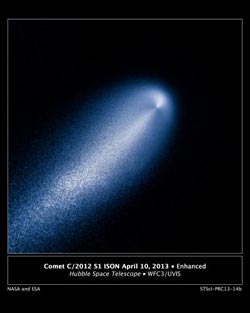Hubble brings faraway comet into view

This contrast-enhanced image of Comet ISON, taken by the Hubble Space Telescope on April 10, 2013, shows dust particle release on the sunward-facing side of the comet's nucleus, the small, solid body at its core. The image was taken in visible light with Hubble's Wide Field Camera 3. Blue false color was added to bring out details in the comet structure.<br>Credit: NASA, ESA, J.-Y. Li (Planetary Science Institute), and the Hubble Comet ISON Imaging Science Team<br>
The NASA Hubble Space Telescope has given astronomers their clearest view yet of Comet ISON, a newly-discovered sun grazer comet that may light up the sky later this year, or come so close to the Sun that it disintegrates. A University of Maryland-led research team is closely following ISON, which offers a rare opportunity to witness a comet's evolution as it makes its first-ever journey through the inner solar system.
Like all comets, ISON is a “dirty snowball” – a clump of frozen gases mixed with dust, formed in a distant reach of the solar system, traveling on an orbit influenced by the gravitational pull of the Sun and its planets. ISON's orbit will bring it to a perihelion, or maximum approach to the Sun, of 700,000 miles on November 28, said Maryland assistant research scientist Michael S. Kelley.
This image was made on April 10, when ISON was some 386 million miles from the Sun – slightly closer to the Sun than the planet Jupiter. Comets become more active as they near the inner solar system, where the Sun's heat evaporates their ices into jets of gases and dust. But even at this great distance ISON is already active, with a strong jet blasting dust particles off its nucleus. As these dust particles shimmer in reflected sunlight, a portion of the comet's tail becomes visible in the Hubble image.
Next week while the Hubble still has the comet in view, the Maryland team will use the space telescope to gather information about ISON's gases.
“We want to look for the ratio of the three dominant ices, water, frozen carbon monoxide, and frozen carbon dioxide, or dry ice,” said Maryland astronomy Prof. Michael A'Hearn. “That can tell us the temperature at which the comet formed, and with that temperature, we can then say where in the solar system it formed.”
The Maryland team will use both the Hubble Space Telescope and the instruments on the Deep Impact space craft to continue to follow ISON as it travels toward its November close up (perihelion) with the sun.
Media contact:
Heather Dewar
Media Contact
More Information:
http://www.umd.eduAll latest news from the category: Physics and Astronomy
This area deals with the fundamental laws and building blocks of nature and how they interact, the properties and the behavior of matter, and research into space and time and their structures.
innovations-report provides in-depth reports and articles on subjects such as astrophysics, laser technologies, nuclear, quantum, particle and solid-state physics, nanotechnologies, planetary research and findings (Mars, Venus) and developments related to the Hubble Telescope.
Newest articles

A universal framework for spatial biology
SpatialData is a freely accessible tool to unify and integrate data from different omics technologies accounting for spatial information, which can provide holistic insights into health and disease. Biological processes…

How complex biological processes arise
A $20 million grant from the U.S. National Science Foundation (NSF) will support the establishment and operation of the National Synthesis Center for Emergence in the Molecular and Cellular Sciences (NCEMS) at…

Airborne single-photon lidar system achieves high-resolution 3D imaging
Compact, low-power system opens doors for photon-efficient drone and satellite-based environmental monitoring and mapping. Researchers have developed a compact and lightweight single-photon airborne lidar system that can acquire high-resolution 3D…





















